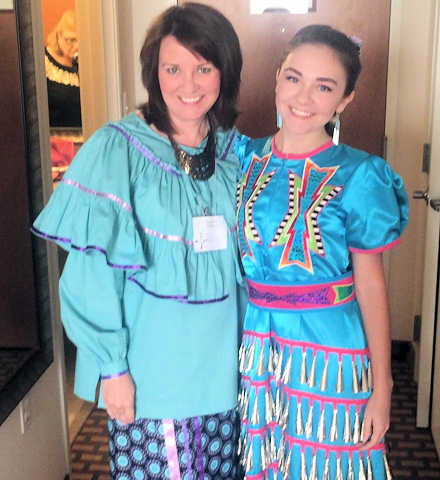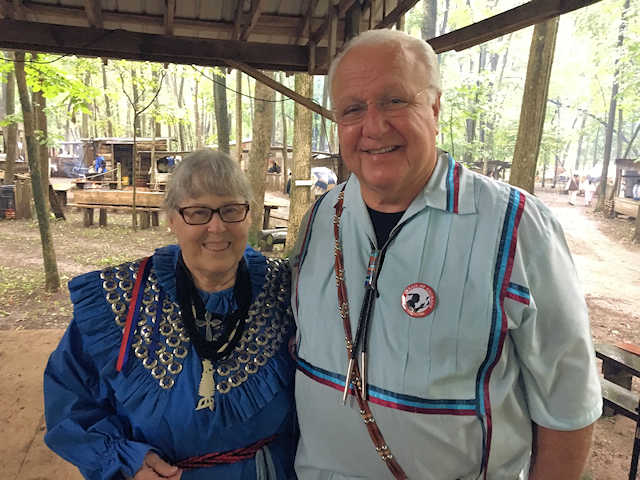|
Always an event that brings never-known history, the 41st Trail of Courage Living History Festival Sept. 17-18 at the Fulton County Historical Society, Rochester, Indiana, will have many special things for the Indiana Bicentennial. The family of John “Rocky” Barrett, chairman of the Citizen Potawatomi Nation, Shawnee, Ok., will be the honored family at the Trail of Courage Living History Festival Sept. 17-18, 2016. A different Potawatomi family is honored every year at the Trail of Courage in its presentation of frontier Indiana. Rocky will be presented a Key to the City of Rochester, Indiana, at the Opening Ceremony on Saturday at 10 a.m. Sept. 17. Similar ceremonies will be held Sunday morning Sept. 18. Barrett is descended from two original Potawatomi families: Daniel Bourassa and Peltier. The Bourassa/ Boursaw family has been honored and written about in previous years, so this year the Peltier history will be researched and written for publication. Many long-time participants will return, including the Aztec Dancers, Indian dancers and drum, mountain men, trade blankets and tents, canoe rides, foods cooked over wood fires, shooting contests, two stages with music and dance, and more. The round barn, taken down by a tornado Aug. 3, 2015, has been rebuilt and so has the cider mill. The 1912 jail and 1860 log cabin have not been repaired yet for lack of funding.
The historical marker is a huge boulder with metal plaque erected by Girl Scouts of Northern Indiana - Michiana Pulaski County Troop 47609, the Gold Award project of Rachel Ploss, Star City, Ind. The Girl Scout leader is Mary Conner, Winamac. Donations are needed to help pay for the metal plaque and can be mailed to PTDA, c/o FCHS 37 E 375 N, Rochester INi, 46975. Citizen Potawatomi Nation donated $500. The total needed is $1,000. The girls have been working hard to earn the rest of the money. Polke was taken by Indians when he was seven years old and learned their language. As an adult he was a missionary to the Potawatomi with his brother-in-law, Rev. Isaac McCoy, at Niles, Mich. Polke was Fulton County’s first white settler, coming in 1830 to survey the Michigan Road, which is Rochester’s Main Street. He built a double log cabin trading post on the south side of the Tippecanoe River, east side of Michigan Road (Old 31). This trading post was also the first post office in Fulton County and Polke was the first post master. The post office was named Chippeway, Indiana. Polke built the county’s first frame house in 1832, and this house/ stagecoach inn was moved the Fulton County Historical Society in 1993. Polke was known to be a friend to the Indians and was appointed federal conductor on the 1838 forced removal, replacing Gen. John Tipton, who was appointed by Indiana Governor David Wallace. Tipton turned the removal over to Polke at Danville, Ill. Father Benjamin Petit caught up with the Potawatomi at Danville, Ill., and cared for the sick and dying. Forty-two died on the 660 mile trip to Kansas, hence it went down in history as the Trail of Death. Julie and Andre Petit will speak at 1:00 to 1:30 on the Hillside stage at the Trail of Courage Sept. 17-18, 2016. Father Petit was from France and became a missionary to the Potawatomi in northern Indiana, learning their language and enjoying their company and thus becoming very beloved by the Potawatomi. He became ill with typhoid, the disease that caused so many Potawatomi to die on their forced emigration to Kansas. Abram Burnett, the same age as Petit, rode back toward Indiana with Petit in January 1839. Petit was so sick, Burnett had to hold him on the horse. Petit died in St Louis and Burnett brought his silver chalice back to Bishop Brute at Vincennes, where it is displayed today in the Old Cathedral museum. Father Petit is buried beneath the Log Chapel at Notre Dame University. Here is where living history comes into play again. Julien Petit, a young man, age 28, the same age as Father Petit when he died, is a relative of his and will be coming to the Trail of Courage. Julien’s grandfather, Andre Petit, age 73, will be with him. Because of Father Petit’s importance in Indiana history, this is an big addition to the Bicentennial. There have always been good and bad events in history, and the forced removals of the American Indians from Indiana is a black mark on the state’s history. We cannot change history, but we can learn from it. We acknowledge the human error made by the Indiana Governor in 1838 in authorizing General John Tipton to round up the Potawatomi and forcibly march them to Kansas. This forced emigration is known as the Trail of Death because over 40 died on the way and are buried in unmarked graves. Today’s Hoosiers regret this inhumane act and wish it had never happened, and we humbly express our sincere sorrow for this event.
A special showing of the documentary “Like Birds in a Wind Storm” will be Friday evening Sept. 16 at the Fulton County Museum. The title refers to how the Potawatomi were scattered after being forcibly removed from Indiana to Kansas in 1838 on the Trail of Death. The annual meeting of the Potawatomi Trail of Death Association will be held at the same time. Susan Green, Rochester, a professional film-maker, made the film from videos of the six Trail of Death caravans, and interviews she did of Potawatomi: George Godfrey, Sister Virginia Pearl and Bob Pearl, and Jon Boursaw. Shown as speakers or dancers at the Trail of Courage are other Potawatomi: Tracy Locke and daughter Erin, Susan Campbell, Janet Pearl, Sharon Hoogstraten and mother Jo Hoogstraten, Ralph and Lois Bazhaw. Erin Locke also plays a part in the portrayal of the Trail of Death removal. Prairie Band Potawatomi shown are Eddie Joe Mitchell, Tom Wabnum and son Marshal. Potawatomi pictured from videos of Trail of Death caravans are Jerry and Hildegard Pearl, Eileen and Jim Pearl, Carmelita Wamego Skeeter and grandson Chris Osborn, Jeannie Wamego Van Veen, Cathryn Wamego, Theresa McNary, Tom Hamilton, Joe and Clara Slavin, Peggy Anderson and daughter Linda. Also pictured at Chief Menominee monument ceremonies or other places are people interested in history: Martin Uebel, Mike Woolfington, Dolores Grizzell, Susan and Juliana Estall, Valerie Berkshire, Howard and Barbara Kline. Bill Wamego is shown in the jail wagon portraying Chief Menominee on the Trail of Death at the 1988 Trail of Courage Living History Festival on Fulton County Historical Society grounds, Rochester. Lawrence Vander Volgen is shown telling about his memories of the Trail of Death as told by his grandfather in Carroll County, Indiana. Navajo Stanley Perry is shown blessing the Trail of Death monument at the Rochester courthouse in 2013.
Tim Harmon, State Representative, is shown reading the proclamation from Governor Mike Pence in 2013. Shirley Willard, Fulton County Historian, who has worked to preserve the Trail of Death history with 80 historical markers and six caravans from Indiana to Kansas, narrates the story. Susan Green also enlisted Trail of Courage participants who became amateur actors, such as the shooters, Ginot Picor as Father Petit, Kim and Denny Setnor as Rochester residents as the Potawatomi were marched down Main Street at gunpoint Sept. 5, 1838, and Colton Sailors as Billy Ward, the little boy who followed the Potawatomi south of town until his mother, played by Sailor Canfield, caught up with him and took him back home. Video footage is from the six caravans taken by Tom Hamilton, Eric Campbell, Bill Willard, Wayne Harvey, Leslie Gee, and Dan Noyes. Pictures from George Winter in 1838 are from the Tippecanoe County Historical Association. George Schricker, Plymouth, played guitar and sang his song, “Menominee.” Jacqui Foreman’s song, “Crying Sky,” was written for her Cherokee Trail of Tears ancestors. Other music is included that fits the theme. Pictures are shown of 2013 Trail of Death Commemorative Caravan attendees at the Chief Menominee statue at Twin Lakes near Plymouth, at the beginning of their journey to Kansas: Bill and Shirley Willard, Janet Pearl, Carmelita Wamego Skeeter, Jeannie Wamego Van Veen, Sister Virginia Pearl, Bob Pearl, Linda and Peggy Anderson, Jerry and Hildegard Pearl, Sharon Hoogstraten and mother Jo Hoogstraten, Chris Osborn, Theresa McNary, George Godfrey, Ralph Bazhaw, and Cathy Wamego. (Photo: David Sherman Begg, also a member of the caravan; this photo and many others are shown on this website.) DVDs of the documentary will be available at the Trail of Courage. To order through the mail, send check for $20 to Potawatomi Trail of Death Assn., 37 E 375 N, Rochester IN 46975. The documentary is one hour long.  |
| < Previous | Home | Next > |
 Shirley Willard, (left) Rochester, Indiana, and John “Rocky” Barrett, tribal chairman of Citizen Potawatomi Nation, on the stage at the Trail of Courage Sep 17, 2016. Shirley is dressed as Mas-saw, a Potawtomi chieftess from Lake Kee-wau-nay, now called Lake Bruce. Barrette’s Peltier family history is available at the Fulton County Museum as a souvenir. Barrett was honored with a key to the city of Rochester at the Trail of Courage. In the background at left is the potato chip booth. (Photo from Linda Capps, vice chairman of CPN).
Shirley Willard, (left) Rochester, Indiana, and John “Rocky” Barrett, tribal chairman of Citizen Potawatomi Nation, on the stage at the Trail of Courage Sep 17, 2016. Shirley is dressed as Mas-saw, a Potawtomi chieftess from Lake Kee-wau-nay, now called Lake Bruce. Barrette’s Peltier family history is available at the Fulton County Museum as a souvenir. Barrett was honored with a key to the city of Rochester at the Trail of Courage. In the background at left is the potato chip booth. (Photo from Linda Capps, vice chairman of CPN).